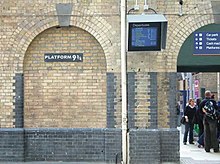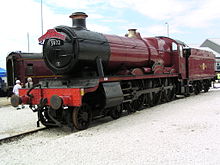Harry Potter
![]()
The title of this article is ambiguous. For other meanings, see Harry Potter (disambiguation).
Harry Potter is a series of novels for children and young adults by the English author Joanne K. Rowling. It tells the story of the titular character Harry Potter, who learns of his magical origins on his eleventh birthday and is henceforth a student at the British wizard boarding school Hogwarts. Each of the seven volumes describes a year of school and life for Harry Potter, his friends and antagonists. The book series, including three spin-offs, has sold over 500 million copies worldwide and has been translated into 80 languages. In German alone, over 33 million Harry Potter books have been sold.
The first part Harry Potter and the Philosopher's Stone (original: Harry Potter and the Philosopher's Stone) was published by Bloomsbury Publishing on 26 June 1997 in a first edition of 500 copies. The second part, Harry Potter and the Chamber of Secrets, followed in 1998, and the third part, Harry Potter and the Prisoner of Azkaban, in 1999. From then on, the books occupied the top places of the bestseller lists in numerous countries, for example in The New York Times or Der Spiegel. The series set a record with the launch of the fourth volume, Harry Potter and the Goblet of Fire, in 2000. Volumes five to seven also broke pre-order records in the UK and the USA, among others.
Between 2001 and 2011, the books were adapted into eight films; the film series is considered one of the most commercially successful in film history. The books and the films triggered a worldwide craze for fantasy books and films in the late 1990s and early 2000s, accompanied by (re)film adaptations of The Lord of the Rings or The Chronicles of Narnia as well as numerous other fantasy book series such as Eragon, Bartimaeus or Percy Jackson.
The Harry Potter heptalogy can be assigned to several literary genres. It has characteristics of a detective novel, a developmental novel and an educational novel, but can also be seen as a modern fairy tale or art fairy tale. Along with the continuing enthusiasm for the Harry Potter books and films, numerous merchandising products have been marketed with great success and a separate theme park has been opened.
.svg.png)
Logo of the original British editions
Content
At the beginning of the story, one-year-old Harry Potter is left on the doorstep of his last living relatives, the Dursleys, as a foundling. His parents James and Lily Potter have been killed shortly before by the most powerful black wizard Lord Voldemort. In an attempt to kill Harry as well, the Death Curse fell on Voldemort and destroyed his body. The boy was left with a lightning-shaped scar on his forehead. Since Harry is thus the only known person to have survived this curse, in addition to being blamed for the disappearance of the greatest dark wizard, he is a celebrity throughout the magical world from a young age and known as "the boy who survived".
Harry grows up until his eleventh birthday with Petunia, his mother's sister, her husband Vernon and their son Dudley. The Dursleys are hostile to the magical world, treat Harry very badly and try to prevent the development of his magical abilities. They conceal from him how his parents died, as well as the fact that Harry is a wizard. On Harry's eleventh birthday, he is delivered an invitation to boarding school by Rubeus Hagrid, the gamekeeper and keeper of the keys at Hogwarts Wizarding School. Only now does he learn about his origins and the existence of the secret magical parallel world.
The action of volumes 1 to 6 takes place mainly in the boarding school Hogwarts, which becomes Harry's center of life. Each year Harry, and with him the reader, gets to know new places and people outside Hogwarts, the horizon of the narrative becomes broader, the plot lines become more complex and many are interwoven.
The reader follows Harry's development from the perspective of an eleven-year-old to an almost adult teenager. For the first time, Harry consciously experiences family-like security in his Gryffindor house, to which he is assigned on his first day at Hogwarts. He finds close friends in classmates Ron Weasley and Hermione Granger, who are his peers - the trio gets through almost all of their adventures together - and a mentor in Headmaster Albus Dumbledore. The fugitive prisoner Sirius Black turns out to be Harry's godfather and becomes his most important caregiver outside of Hogwarts. Harry also has a friendly relationship with his former teacher Remus Lupin. With the teacher Severus Snape, on the other hand, as well as with his classmate Draco Malfoy from the traditionally rival Slytherin house, he has a mutual hatred.
The central theme of the story is increasingly Harry's confrontation with Lord Voldemort, who continues to exist as a spirit-like being after attacking Harry and tries to regain his body. Twice Harry is able to prevent this from happening: In the first volume, he foils Voldemort's plan to steal the "Philosopher's Stone"; in the second volume, he destroys a magical image of the 16-year-old Voldemort that he had hidden in a diary.
In the fourth volume Harry has to watch powerlessly as Voldemort gets a new body and begins to gather his followers around him again. After Harry subsequently escapes two more of Voldemort's murder attempts, he learns of a prophecy of his demise in the fifth volume. It is the reason why Voldemort wanted to kill him as a baby and continues to try, because according to it, Harry is the only one who can break his power.
In the sixth volume, it turns out that Voldemort has hidden parts of his soul in Horcruxes in order to gain immortality in this way. Several conflicts escalate, setting up the finale in the final book. In the key scene, Draco Malfoy fails in his attempt to kill Albus Dumbledore - Severus Snape takes over the task and subsequently flees with Draco.
In the seventh and final volume, Harry, Hermione and Ron set out to find and destroy the remaining Horcruxes. Because Voldemort has in the meantime brought the Ministry of Magic under his influence and controls the entire country, they narrowly escape death several times during their sometimes aimless search.
During the final battle at Hogwarts, Harry learns that he must die to make Lord Voldemort mortal because he carries a part of Voldemort's soul within him. He surrenders to this fate and faces the Dark Lord unarmed, but again survives the Death Curse while Voldemort's soul fragment is destroyed within him. When Voldemort presents Hogwarts' defenders with the body of Harry, who was thought dead, his snake Nagini, who was the seventh and final Horcrux, dies when Neville Longbottom, a school friend of Harry's, cuts off its head with the sword of Godric Gryffindor. Harry emerges victorious from the decisive duel that follows, as Voldemort dies by his own reflected death curse, thus fulfilling the prophecy.
The final volume concludes with a chapter that takes a look 19 years into the future: both Harry and Ginny (Ron's younger sister) and Ron and Hermione have married, and their children are going to Hogwarts together.
The Harry Potter World
The action of the Harry Potter novels takes place in two co-existing worlds. One is the world known to the reader, more specifically the United Kingdom at the end of the 20th century. The other is a parallel magical society largely hidden from non-magical people - called "Muggles" - populated by wizards, witches and non-human magical beings. This wizarding society has its own government and administration in Britain, the Ministry of Magic, as well as its own economic system.
The magical world decided on this separation centuries ago and enforces it with appropriate secrecy laws and controls, but also with magic. Only the respective acting Prime Minister of the Muggles is informed of the existence of the Wizarding World by the respective acting Minister of Magic. The transitions between the two worlds are invisible to Muggles, such as the entrance to Angle Alley, a shopping street for wizards and witches in the middle of London. Conversely, wizards and witches can move freely in the non-magical world, but many of them avoid the company of Muggles. Due to segregation over many generations and a widespread disdain for Muggles, most wizards and witches are poorly informed about the non-magical world and often stand out there due to completely inappropriate clothing and their ignorance of technical devices.
Compared to British society around the year 2000, the way of life of wizards and witches seems backward. They dress in ancient robes and are unaware of electrical devices or modern information technology. However, there are numerous magical devices that perform similar functions. For example, people in photographs and painted images can move and sometimes communicate independently. Technical means of transportation are replaced by flying brooms or apparating within seconds, and a nationwide network of fireplaces allows travel and communication over long distances. On the other hand, the witches and wizards also possess 20th century vehicles, though all of them are antiquated: The Hogwarts Express is pulled by a steam locomotive, an obsolete triple-decker omnibus picks up stranded witches and wizards, and the Weasleys use a historic car that has a flying spell cast on it.
Both worlds are not completely separated from each other. Time and again, wizards violate the separation rules. In these cases, the Ministry of Magic tries to repair any damage and alter the memory of the Muggles involved. In some cases, however, the effects of magical activity are too serious to conceal. In particular, Lord Voldemort's criminal activities repeatedly force the Minister of Magic to contact the British Prime Minister, who in this way learns the real cause of mass accidents, supposed natural disasters and weather phenomena.
The following four articles describe important characters, plot locations, terms, and animals and species from the Harry Potter novels, and thus an essential part of the Harry Potter universe:
- Characters in the Harry Potter novels
- Locations of the Harry Potter novels
- Terms of the Harry Potter novels
- Animals of the Harry Potter novels

The fictitious platform 9¾ at King's Cross station.

Locomotive in the style of the traction engine of the "Hogwarts Express".
Questions and Answers
Q: What is Harry Potter?
A: Harry Potter is a series of seven fantasy novels and eight movies by J. K. Rowling, a British author. It is named for its protagonist and hero, Harry Potter.
Q: How many books have been sold in the series?
A: Seven books in the series have sold over 500 million copies across the world in over 70 languages including Latin, Welsh and Ancient Greek, making it the best-selling book series of all time.
Q: Who adapted the books into movies?
A: The books were adapted into movies by Warner Bros.
Q: When was the first movie released?
A: The first movie was released in 2001.
Q: What year was the sixth movie released?
A: The sixth movie, Harry Potter and the Half Blood Prince, was released in 2009.
Q: When were the two parts of Deathly Hallows released? A: The first part, Harry Potter and the Deathly Hallows Part 1, was released in 2010 while Harry Potter and the Deathly Hallows Part 2 was released in 2011.
Q: Are there any spin-off movies or TV specials related to this franchise? A: Yes, several spin-off movies were released in 2016, 2018 and 2022 respectively as well as some TV specials for HBO Max also set to be released in 2022.
Search within the encyclopedia